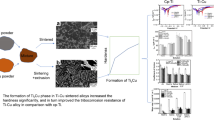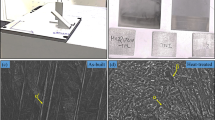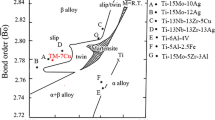Abstract
The current work related to investigate wear and corrosion properties for addition three weight% of copper to Ti–18Nb alloy using powder metallurgy technique including (5, 7 and 9 wt%). The percent of 7% gave the lowest wear rate for base alloy (Ti–18Nb) because of formation a hard Ti2Cu phase, with different properties for the corrosion behavior because of the variation in produced cathodic and anodic areas in tested medium (simulated body fluid) and then increasing the micro-galvanic cells over the alloy’s surface, adding 9% Cu gave polarization resistance equal to (448.46 kΩ cm2) that was higher than resistance of base alloy and alloy with 5 and 7% Cu. Atomic force microscopy was used to analysis the surface topography with measuring the roughness of surface; also 7% of Cu gave the highest surface roughness (20.06 nm) compared with other percents due to the formed hard phase.








Similar content being viewed by others
Data Availability
All measurements and data are listed in published article.
References
Yoshimitsu O (2001) A new Ti–15Zr–4Nb–4Ta alloy for medical applications. Curr Opin Solid State Mater Sci 5:45–53
Godley R, Starosvetsky D, Gotman I (2006) Corrosion behavior of a low modulus β-Ti–45%Nb alloy for use in medical implants. J Mater Sci Mater Med 17:63–67
Assis S, Wolynec S, Costa I (2008) The electrochemical behaviour of Ti–13Nb–13Zr alloy in various solutions. Mater Corros 59:739–743
Danielle Q, Martins W, Osório M, Souza R, Caram A (2008) Effects of Zr content on microstructure and corrosion resistance of Ti–30Nb–Zr casting alloys for biomedical applications. Electrochim Acta 53(6):2809–2817
Cvijović-Alagić I, Cvijović Z, Mitrović S, Panić V, Rakin M (2011) Wear and corrosion behaviour of Ti–13Nb–13Zr and Ti–6Al–4V alloys in simulated physiological solution. Corros Sci 53:796–808
Yong Y, Meng Q, De-sheng C, Xiao-bing X, Xian-long Z (2012) In vitro corrosion resistance and cytotoxicity of novel TiNbTaZr alloy. Trans Nonferr Met Soc China 22:s175–s180
Ana L, Roselino R, Peter H, Luís G, Luís A (2013) Are new TiNbZr alloys potential substitutes of the Ti6Al4V alloy for dental applications: an electrochemical corrosion study. Biomed Mater 8:6. https://doi.org/10.1088/1748-6041/8/6/065005
Jose M, Cora V, Silviu I, Steliana I, Petre O, Paula D, Monica P, Silviu P, Ecaterina V (2014) Microstructural and mechanical properties, surface and electrochemical characterisation of a new Ti–Zr–Nb alloy for implant applications. J Alloys Compd 612:398–410
Weijiu H, Zhenguo W, Chenglong L, Yongmei Y (2015) Wear and electrochemical corrosion behavior of biomedical Ti–25Nb–3Mo–3Zr–2Sn alloy in simulated physiological solutions. J Bio Tribo Corros 1:1
Correa D, Kuroda P, Grandini C, Rocha L, Oliveira F, Alves A, Toptan F (2016) Tribocorrosion behavior of β-type Ti–15Zr–based alloys. Mater Lett 179:118–121
Mianmian B, Xiaoyan W, Lei Y, Gaowu Q, Erlin Z (2018) Tribocorrosion behavior of Ti–Cu alloy in Hank’s solution for biomedical application. J Bio Tribo Corros 4:1
Ureña J, Tsipas S, Pinto A, Toptan F, Gordo E, Jiménez A (2018) Corrosion and tribocorrosion behaviour of β-type Ti–Nb and Ti–Mo surfaces designed by diffusion treatments for biomedical applications. Corros Sci 140:51–60
Fabiana L, Leonardo M, Maria R, Cesar A, Célia M (2020) A new ternary alloy Ti26Zr24Nb for biomedical application: behavior in corrosion, wear, and tribocorrosion. J Bio Tribo Corros 6:86
Mahundla M, Matizamhuka W, Yamamoto A, Shongwe M, Machaka R (2020) Corrosion behaviour of Ti–34Nb–25Zr alloy fabricated by spark plasma sintering. J Bio Tribo Corros 6:38
Jassim M, Haydar H, Shahad R (2021) Investigation of the effect of indium addition on the mechanical and electrochemical properties of the Ti–15Mo biomedical alloy. J Bio Tribo Corros 7:148
Shivaram M, Shashi B, Jagannath N, Bharat B (2021) Tribocorrosion behaviour of biomedical porous Ti–20Nb–5Ag alloy in simulated body fluid. J Bio Tribo Corros 7:59
Mohamed A, Abdul A, Madhan A, Saravanan S, Nestor A, Ahmad S (2023) Design and processing of near-β Ti–Nb–Ag alloy with low elastic modulus and enhanced corrosion resistance for orthopedic implants. J Mater Res Technol. https://doi.org/10.1016/j.jmrt.2023.03.003
Aydin B, Michael G (2023) Electrochemical and biological characterization of Ti–Nb–Zr–Si alloy for orthopedic applications. Sci Rep. https://doi.org/10.1038/s41598-023-29553-5
Ludovico A, Jithin V, Yohan D, Kevin P, Ana-Maria S, Nicolas C, Annett G, Benoit T, Mariana C (2023) Tribocorrosion behavior of β-type Ti–Nb–Ga alloys in a physiological solution. Tribol Int. https://doi.org/10.1016/j.triboint.2023.108325
Petr V, Jaroslav F, Jan K, Jan D, Vojtech S (2021) Surface pre-treatments of Ti–Nb–Zr–Ta beta titanium alloy: the effect of chemical, electrochemical and ion sputter etching on morphology, residual stress, corrosion stability and the MG-63 cell response. Results Phys 28:104613
Hsin Ch, Yung S, Pei P, Yung P, Keng O (2008) Biomechanical research of Ti–Nb alloys with electrochemical treatment using finite element method. ECS Trans 13:1–11
Kikuchi M, Yukyo M, Takada Y, Kiyosue S, Yoda M, Woldu M, Cai Z, Okuno O, Okabe T (2003) Mechanical properties and microstructures of cast Ti–Cu alloys. Dent Mater 19:174–181
Ilven M, Sinem Y, Enver O (2016) Production and precipitation hardening of beta-Type Ti–35Nb–10Cu alloy foam for implant applications. J Mater Eng Perform 25:1586–1593
Anaee R (2016) Behavior of Ti/HA in saliva at different temperatures as restorative materials. J Bio Tribo Corros 2:5
Imen G, Wafa S, Paula O, Sergio C, Achraf G, Mario D (2022) Optimization and comparison study of adsorption and photosorption processes of mesoporous nano–TiO2 during discoloration of Indigo Carmine dye. Microporous Mesoporous Mater 342:112138
Sassi W, Dhouibi L, Hihn J, Berc P, Rezrazi M, Ammar S (2019) Corrosion protection of Cu electrical cable by W–Ni composite coatings doped with TiO2 nanoparticles: influence of pulse currents. J Mater Eng Perform. https://doi.org/10.1007/s11665-019-04288-5
Wang Y, Zheng Y (2009) Corrosion behaviour and biocompatibility evaluation of low modulus Ti–16Nb shape memory alloy as potential biomaterial. Mater Lett 63:1293–1295
Mutlu I, Oktay E (2015) Localised corrosion behaviour of biomedical implant materials using electrochemical potentiokinetic reactivation and critical pitting potential methods. Corros Eng Sci Technol 50:72–79
Mutlu I, Yeniyol S, Oktay E (2016) Characterisation of corrosion properties of Ti–Nb–Cu alloy foam by electrochemical impedance spectroscopy method. Corros Eng Sci Technol 51:110–117
Naema A, Ahlam M, Anaee R (2009) Effect of chloride ions on the passive layer for three Al- alloys at pH = 9. J Al-Nahrain Univ 12:23–32
Anaee R, Wafaa M, Ban F (2017) Improvement in corrosion behavior of Al–Ti alloy by adding 2 wt% magnesia and 1 wt% silicon carbide. J Bio Tribo Corros 3:38
Noor N, Ali H, Anaee R (2022) Effect of indium coating on corrosion behavior of AZ31 mg alloy by DC sputtering. Mater Today Proc 62:4551–4555
Hiba A, Raad S, Anaee R (2022) Deposition of CaO to protect carbon steel by electrophoretic method. Mater Today Proc 26:4556–4561
Cheng X, Nan W, Yongnan Ch, Binbin H, Qinyang Z, Lei Ch, Yufei T, Binli L, Yongqing Z, Xiaokang Y (2022) Biological corrosion behaviour and antibacterial properties of Ti–Cu alloy with different Ti2Cu morphologies for dental applications. Mater Des 215:110540
Ren L, Ma Z, Li M, Zhang Y, Liu W, Liao Z, Yang K (2014) Antibacterial properties of Ti–6Al–4V–xCu alloys. J Mater Sci Technol 30:699–705
Daroonparvar M, Khan M, Saadeh Y, Kay C, Kasar A, Kumar P, Esteves L, Misra M, Menezes P, Kalvala P, Bakhsheshi-Rad H, Gupta R (2020) Modification of surface hardness, wear resistance and corrosion resistance of cold spray Al coated AZ31B mg alloy using cold spray double layered Ta/Ti coating in 3.5 wt% NaCl solution. Corros Sci 176:109–1029
Gai X, Bai Y, Li S, Hou W, Hao Y, Zhang X, Yang R, Misra R (2020) In-situ monitoring of the electrochemical behaviour of cellular structured bio medical Ti–6Al–4V alloy fabricated by electron beam melting in simulated physiological fluid. Acta Biomater 106:387–395
Noor N, Ali H, Anaee R (2022) Annealing and coating influence on the mechanical properties, microstructure, and corrosion properties of biodegradable mg alloy (AZ91). J Bio Tribo Corros 8:64
Sato K, Takahashi M, Takada Y (2020) Construction of Ti–Nb–Ti2Cu pseudo-ternary phase diagram. Dent Mater J 39:422–428
Acknowledgements
This work was achieved at Karabuk University and University of Technology—Department of Materials Eng.
Funding
No funding.
Author information
Authors and Affiliations
Corresponding author
Ethics declarations
Conflict of interest
No conflicts for interests.
Additional information
Publisher’s Note
Springer Nature remains neutral with regard to jurisdictional claims in published maps and institutional affiliations.
Rights and permissions
Springer Nature or its licensor (e.g. a society or other partner) holds exclusive rights to this article under a publishing agreement with the author(s) or other rightsholder(s); author self-archiving of the accepted manuscript version of this article is solely governed by the terms of such publishing agreement and applicable law.
About this article
Cite this article
Demirtaş, H., Riyadh, M. & Anaee, R. Wear and Corrosion Properties for the Effect of Addition Cu to Ti–18Nb Biomaterial. Chemistry Africa 6, 3185–3193 (2023). https://doi.org/10.1007/s42250-023-00690-8
Received:
Accepted:
Published:
Issue Date:
DOI: https://doi.org/10.1007/s42250-023-00690-8




